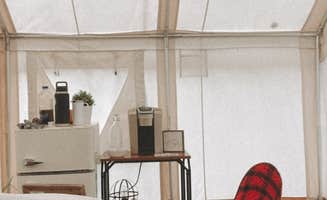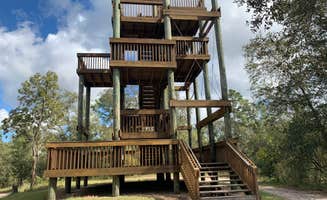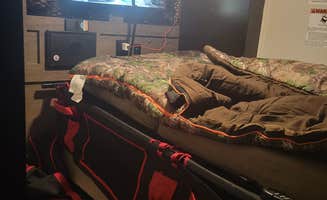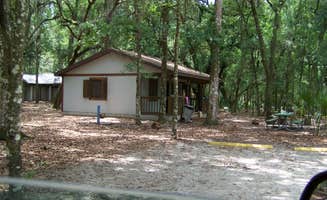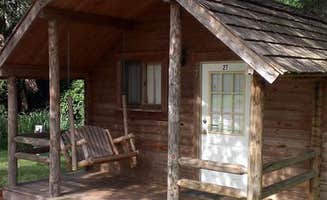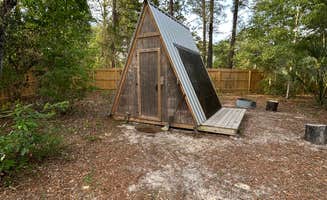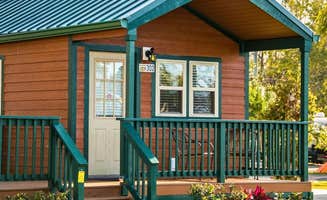Glamping close to Plant City, Florida offers diverse terrain across three counties within short hiking distances. The Tampa-adjacent region features class 2 rapids on the Hillsborough River with water levels that fluctuate seasonally, affecting accessibility for overnight stays. Summer temperatures regularly exceed 90°F with high humidity from June through September, making proper site selection crucial for comfort.
What to do
Wildlife viewing opportunities: Withlacoochee River Park features diverse animal sightings throughout its natural areas. "We saw armadillos, turtles, large Ospreys, and a small gator by the fishing dock," reports a visitor from Withlacoochee River Park, highlighting the park's ecological diversity. The park provides both observation areas and fishing access.
Multi-day hiking expeditions: Green Swamp West offers extended backcountry routes for serious hikers. "This totally primitive site can be found 12 miles out from the McNeil Trailhead near Colt Creek State Park on Hwy 471. Choose your hiking dates well, the warmer and more humid the more difficult the hike," notes a Foster Bridge Primitive Site camper. The area contains 65 miles of trails across 37,350 acres.
Equestrian facilities: Several parks accommodate horse owners with dedicated camping areas. "There are separate equestrian sites in the area and separate trails as well," mentions a reviewer at Foster Bridge Primitive Site. Disney's Fort Wilderness offers horse corral facilities for those bringing their own horses.
What campers like
Privacy between sites: The vegetative buffers at several parks create natural separation. "We are in a 24' class C and found a nice private area that was surprisingly level," notes a Cypress Creek Preserve visitor, highlighting the importance of site selection. The preserve's dispersed camping layout gives campers more space than typical established campgrounds.
Budget-friendly options: Several free or low-cost camping areas exist near Plant City. "FREE camping, i love. Nice and quiet, i use a quiet run generator and bring in 50 gallons of fresh water for weekend stays," reports a camper at Upper Hillsborough Preserve. Advance reservations are required for most free sites, despite their primitive nature.
Night sky viewing: Areas away from urban light pollution offer stargazing opportunities. "This place is quiet and dark at night," remarks a reviewer at Withlacoochee River Park. "On new moon nights the local astronomy club uses neighboring field to gaze at the stars," providing organized astronomy events for visitors.
What you should know
Insect preparation is essential: Multiple parks report significant bug issues depending on season. "The mosquitoes here are big enough to carry away a small dog," warns a Hillsborough River camper. Another notes, "Bring good bug spray," at Fort De Soto Campground, emphasizing this as a regional challenge rather than park-specific.
Water access varies significantly: Many parks have water bodies but limited access points. "Parts of these trails can be filled with water (large puddles)," mentions an Upper Hillsborough reviewer about seasonal flooding. Water level fluctuations affect both trail conditions and campsite availability.
Reservation requirements differ: Each park operates under different reservation systems. "I couldn't make a reservation on the website so I strolled in hoping to reserve a site at the front desk. The lady was very helpful and got me a great site," explains a Fort De Soto camper, highlighting the sometimes inconsistent booking processes.
Tips for camping with families
Playground accessibility: Several parks offer dedicated children's play areas. "There is a playground with good swings and also a sturdy playground that offered plenty of opportunity for my four year old to blow off some steam," notes a camper at Fort De Soto. "The ground is all recycled rubber, which I love as a parent."
Educational wildlife opportunities: Parks provide structured learning experiences. "Chip and dale walk around to everyone. They ask that you don't leave your spot and they will come to you and really they do. They stopped at every spot to take pictures," shares a Disney's Fort Wilderness visitor about the character experiences integrated with camping.
Transportation considerations: Some larger parks require additional planning. "Buses run very frequently and never had an issue getting a bus to the amenities. We took the bus to the marina area for dinner at the buffet, to watch the fireworks/light show, and to see Cinderella's horses and carriage," explains a Disney's Fort Wilderness camper about internal transit options.
Tips from RVers
Site access challenges: Several parks have tight turns or narrow roadways. "Our neighbor across from us had to move his truck and several neighbors were helping direct us into our spot. Everyone we spoke with complained about the lack of space to get a big rv into these spot," reports a Fort Wilderness camper with a 27-foot RV.
Concrete pad availability: Level surfaces matter for larger rigs. "Very good service. Nice park. Level concrete pads. Ours was pull through," notes a Quail Run RV Park visitor, highlighting an important consideration for RVers seeking glamping amenities near Plant City.
Dump station locations: Not all parks offer sewer hookups at sites. "We had site 55 of the East CG which was right on the water where we launched our kayaks to paddle the canals amongst the Mangroves," mentions an E.G. Simmons camper, noting the park has "two separate campgrounds each with a dump station and bath house."


